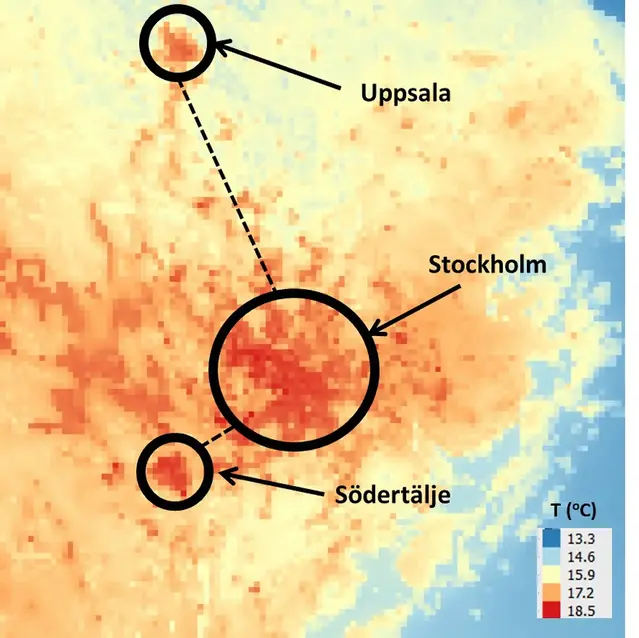BRIGHT – Advancing knowledge and tools for the adaptation of Swedish cities to heat
Project BRIGHT aims to contribute with new knowledge, optimized methods, enhanced tools and user tailored data that enable Swedish municipalities to better adapt to climate change, with a focus on heat waves. A prototype visualisation platform will be developed that integrates knowledge from high resolution modeling data, local meteorological observations and citizen experiences.
Increasing temperatures present significant challenges to cities, amplified by built-up surfaces, urban heat islands and densely populated areas. The impacts of the record hot summer of 2018 have raised the need and urgency of Swedish cities to implement efficient climate change adaptation solutions.
Realising this challenge, the BRIGHT project aims to contribute with new knowledge, optimized methods, enhanced tools and user tailored data that enable Swedish municipalities to better adapt to heat waves.
A prototype visualisation platform will be coproduced with stakeholders from the municipalities of Stockholm, Linköping and Norrköping. The urban climate will be simulated with an event-based dynamical downscaling technique, while a citizen sensing mobile application will engage inhabitants in providing feedback on thermal comfort.
BRIGHT’s interactive tool will enable the exploration of novel ways of integrating high-resolution modeling and monitoring data, offering a unique basis for comparison and cross-case learning. It will support the identification of vulnerable sites and provide assessments of adaptation options and their effectiveness, but also potential side effects on air quality.
By gathering a multidisciplinary group of scientists and practitioners, and building on advanced modelling, sensing, adaptation and climate change communication, BRIGHT will ultimately be contributing to future sustainable and resilient cities with reduced heat related health risks.

Stockholm's urban heat archipelago as simulated by the weather forecast model HARMONIE-AROME at 1km spatial resolution. The image shows mean air temperature between the 15th of June and the 15th of July 2014.

Park Cool Island (PCI) effect represented as Mean Radiant Temperature over Eskilstuna on the 26 July 2014. Results provided by radiation model SOLWEIG at 2m spatial resolution with boundary conditions from HARMONIE-AROME. (copyright: SMHI)
Project goals
BRIGHT's main goal is to:
- Study the impact of the city´s physiography on its climate, namely by identifying urban heat/cold islands, but also how on-going expansion and densification will interact with climate change;
- Define, together with stakeholders, targeted climate change adaptation through urban greening, and to assess effectiveness on mitigating heat islands and possible side effects on air quality;
- Co-produce tailored climate information, fulfilling well-established knowledge quality criteria of credibility, legitimacy, saliency, usability, and usefulness;
- Assess if, and to what degree, the information co-produced by scientists, practitioners and citizens can contribute to the objectives defined in the cities’ environment programmes and climate adaptation plans.
Research method
- A dynamical downscaling technique will provide high resolution simulations of the urban climate of Stockholm, Linköping and Norrköping, allowing to bring the climate signal down to the individual scale;
- A large number of low-cost temperature sensors will be deployed, providing an improved network of urban weather observations;
- A citizen sensing mobile application will engage inhabitants in validating and providing feedback on thermal comfort based on user-tailored indices, providing valuable information towards the investigation of how people perceive and respond to heat;
- A prototype visualization platform will be co-created together with stakeholders where visual representations and the Norrköping Decision Arena will be used to support dialogues among urban planning stakeholders. The visualization platform will enable the exploration of novel ways of integrating high resolution modeling and monitoring data, offering a unique basis for comparison and cross-case learning between cities with different characteristics. This tool will support the identification of risk-areas and the associated vulnerabilities to provide a foundation for assessing adaptation options and their effectiveness.
About the project
Project participants
BRIGHT is coordinated by Jorge H. Amorim at SMHI’s meteorology research team. Other researchers from SMHI: Christian Asker, Isabel Ribeiro, Fuxing Wang and Danijel Belusic.
Participants from Linköping Linköping University (LiU), The Department of Thematic studies (TEMA): Lotten Wiréhn, Tina Neset, Carlo Navarra and J Jacob Wikner.
The project is a collaboration between the cities of Stockholm, Linköping and Norrköping, from which stakeholders will participate.
Funding
BRIGHT is funded by the Swedish Research Council for Sustainable Development Formas, under the call “Climate adaptation of the built environment 2021”.
Time plan
BRIGHT will run from december 2021 to november 2025.

